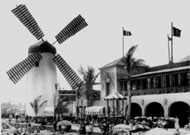World War One
was over. It was safe to travel by train or ship and the tourists
returned to Miami Beach.
New hotels were opening on the beach and each fought to become
the fashionable hotel to spend the winter season. The rich
and famous wanted their place in the sun. Polo grounds and
golf courses turned the island green. The boom was on.
Between 1920 and 1929 millionaires like Harvey Firestone,
J.C. Penny. Harvey Stutz, Albert Champion, Frank Seiberling,
Rockwell LaGorce, Roy Chapin, Alfred DuPont, R.J. Renyolds,
and William Randolph Herst built mansions on the three-mile
stretch known as "Millionaires Row."
Between 1921 and 1925 Fisher built several elegant hotels,
none of which were located on the ocean.
Real Estate values soared 1000 percent between 1914 and 1925
leading speculators to believe they could make huge profits
overnight.
In 1921 there were five hotels and nine apartment houses on
Miami Beach. The following figures reflect this period of
rapid growth. By the end of 1925 the community boasted:
- 56 hotels (4,000 rooms)
- 178 apartment buildings
- 858 private residences
- 308 shops and offices
- 8 bathing casinos
- 4 polo fields
- 3 golf courses
- 3 schools
- 2 churches
Then, on September 19, 1926 Miami Beach was struck by a severe
hurricane.
Hotels were damaged, telephone and electricity service was
knocked out and almost 400 people were killed. The hurricane
turned the real-estate boom into a bust.
On February 11, 1928, John Collins died. Later that Year,
Al Capone's gang moved to Miami Beach, buying a house on Palm
Island. Gambling and bootlegging activities proliferated on
the Beach before his arrival, but when Canoe's gang showed
up, the illegal operations became big business.
The stock market crash of 1929 turned the nation's economy
into a Great Depression. The depression forced the rich Miami
Beach residents to close their estates and move off the beach.
| Miami
Beach history guide |
|
|














